
E-mail: font@focusonnature.com
Phone: Toll-free in USA 1-888-721-3555
or 302/529-1876
Website: www.focusonnature.com
 |
PO Box 9021,
Wilmington, DE 19809, USA E-mail: font@focusonnature.com Phone: Toll-free in USA 1-888-721-3555 or 302/529-1876 Website: www.focusonnature.com |
Rare Birds in the
Caribbean
noting those found
during Focus On Nature Tours
Followed by a List of West Indian Birds
that have become Extinct

In the listing that follows, endemics to the
various islands are noted.
Upcoming FONT Birding & Nature Tours in the Caribbean FONT Past Tour Highlights
A Caribbean Bird-List & Photo Gallery, in 2 Parts:
Part 1: Guineafowl to Hummingbirds
Part 2: Trogons to Buntings
Bird-Lists for:
Cayman Islands
Jamaica
Lesser
Antilles Puerto
Rico Dominican Republic
![]()
Islands where birds have been seen during FONT tours are noted in the following list.
SPECIES OF CARIBBEAN BIRDS
Classified as CRITICALLY THREATENED:
Cuban Kite Ridgway's Hawk
Zapata Rail Grenada Dove Puerto Rican
Amazon
Bahama Oriole
Montserrat
Oriole
Classified as ENDANGERED:
Black-capped Petrel
Gundlach's Hawk Blue-headed Quail-Dove Imperial
Amazon
Bay-breasted Cuckoo
Puerto Rican Nightjar Giant
Kingbird Bahama Swallow
Zapata Wren LaSelle Thrush
White-breasted
Thrasher Whistling Warbler
Yellow-shouldered Blackbird Jamaican Blackbird
Cuban (or Zapata) Sparrow
Saint Lucia Black
Finch Hispaniolan Crossbill
Red Siskin Eastern Chat-Tanager
Classified as VULNERABLE:
West
Indian Whistling Duck Ring-tailed Pigeon
White-fronted Quail-Dove Gray-headed Quail-Dove
Hispaniolan
Parakeet Hispaniolan Amazon
Yellow-billed Amazon Black-billed Amazon
Red-necked Amazon Saint Lucia
Amazon Saint Vincent Amazon
Yellow-shouldered Amazon
Fernandina's
Flicker White-necked
Crow Golden Swallow
Forest Thrush
Bicknell's Thrush
Elfin Woods
Warbler Cerulean Warbler Hispaniolan Highland Tanager
Western Chat-Tanager
Classified as NEAR-THREATENED:
Black Rail
Caribbean Coot Piping Plover Buff-breasted
Sandpiper White-crowned
Pigeon
Plain Pigeon Crested Quail-Dove Rose-throated Amazon Least
Poorwill Bee Hummingbird
Hispaniolan
Trogon Guadeloupe
Woodpecker Hispaniolan Palm Crow Blue
Mountain Vireo
Cuban Solitaire Golden-winged Warbler Vitelline
Warbler Barbuda Warbler
Bahama
Warbler
Kirtland's Warbler
Saint Lucia Oriole Gray-crowned Palm Tanager
Species that are either now EXTINCT or assumed to be:
Jamaican Petrel Eskimo Curlew
Cuban, or Hispaniolan Red
Macaw (& other psittacids)
Jamaican Poorwill
Brace's Hummingbird
Cuban Ivory-billed Woodpecker
Grand Cayman Thrush Bachman's Warbler
Semper's Warbler
![]()
Species in the Caribbean classified as CRITICALLY THREATENED:
1 CUBAN KITE ______
(endemic to Cuba)
Chrodrohierax wilsonii
The Cuban Kite, with an isolated and very small population on Cuba, has been
considered a subspecies of the Hook-billed Kite, Chondrohierax
uncinatus.
2 RIDGWAY'S HAWK
______ Dominican
Republic
(endemic)
Buteo ridgwayi
Only on Hispaniola (and now only in the Dominican Republic), the
Ridgway's Hawk is said to
have once been widespread throughout the island. Certainly it was more common
than it is today.
Now, in fact, it is very rare, with a total population estimated as being from
50 to 250 birds.
Most recent records of the Ridgway's Hawk have been in the northeastern Dominican Republic in the
area of the Los Haitises National Park. Surveys in that park in 2002 and 2003,
found up to 37 pairs. Several nests were discovered and monitored.
However, elsewhere in the country very few individuals could be found of this
apparently still-declining raptor.
A few birds have also been recorded,
in recent years, in the southwestern Dominican Republic, in the area of the
Sierra de Baoruco (Baoruco Mountains). A nest was found in that region back in 1997.
3 individual Ridgway's Hawks were seen during the FONT Dominican Republic tour in March 2003,
in the southwestern part of the island. The birds were not far from us, as they were
seen one morning, in rising thermals as they circled low above a valley.
3 ZAPATA RAIL ______ (endemic to Cuba)
Cyanolimnas cerverai
4 GRENADA DOVE ______
Grenada (endemic)
Leptotila wellsi
The Grenada Dove is closely related to the Gray-fronted Dove of Central & South America,
Leptotila rufaxilla. The two have been said by some to be conspecific.
5 PUERTO RICAN AMAZON
(or Puerto Rican Parrot) ______ Puerto Rico
(endemic)
Amazona v. vittata (a second subspecies on Culebra Island,
A. v. gracilipes, is now
extinct)
The Puerto Rican Amazon (or Puerto Rican
Parrot) is now the rarest of the Caribbean island
amazons. The bird has
been critically endangered for years. Formerly occurring in various areas of
Puerto Rico, it has become very localized in a small, hilly area of
northeastern Puerto Rico.
In 1975, there were only 13 Puerto Rican Amazons in the wild. From that unlucky
low, the number about 10 years later was 30. In the late 1990s, the global
population was 44 in the wild and 87 in captivity.
During our March 2004 tour in that part of Puerto Rico, we saw 1 wild Puerto
Rican Amazon. It was in the area of the facility with the birds in the captive
breeding program. The bird apparently was drawn to the noise of the caged birds'
calls in the afternoon. It appeared to be a bird preferring to forfeit its
lonely wildness for companionship in captivity (Parrots are social birds).
The Puerto Rican Amazon has been seen during 11 FONT tours since 1990. The most
seen were 12 individuals in March 1996. Prior to March 2004, our most-recent
sighting was in
March 2000.
The Puerto Rican Amazon has come close to following the fate of the amazon
parrots that once were in Guadeloupe and Martinique, and the macaws that were in
Cuba and elsewhere in the Caribbean - see the listing of "EXTINCT BIRD SPECIES"
before the end of this list.
7 BAHAMA ORIOLE ______ Bahamas (endemic)
Icterus northropi
In 2010, four endemic subspecies of what was the Greater Antillean
Oriole were elevated to being full species:
the Hispaniolan Oriole, Icterus dominicensis
the Puerto Rican Oriole, Icterus portoricensis
the Cuban Oriole, Icterus melanopsis
the Bahama Oriole, Icterus northropi
Shortly thereafter, in 2011, the Bahama Oriole was classified by Birdlife
International as "critically endangered".
Historically, the Bahama Oriole was found on the Bahamian islands of
Abaco and Andros. For unknown reasons, the Abaco population disappeared during
the early 1990s, and there is evidence that the Andros population is in decline.
Recent surveys (in 2010) of the three main islands forming Andros recorded 81
orioles on North Andros, 22 on Mangrove Cay, and 24 on South Andros, making a
total of 121 birds. Based on these figures, the estimated total population is
fewer than 250 individuals.
The survey found that the orioles occur mainly in human-altered habitat, such as
residential and agricultural land, during the breeding season.
However, nearby natural habitat, particularly coppice (dry-broadleaf forest),
appears to be important, year-round, for the survival of the Bahama Oriole.
8 MONTSERRAT ORIOLE ______ Montserrat
(endemic)
Icterus oberi
Species in the
Caribbean classified as ENDANGERED:
9
BLACK-CAPPED PETREL
______ Puerto Rico (during
a FONT pelagic trip)
Pterodroma h. hasitata
The Black-capped Petrel has a very small, fragmented, and declining breeding
range that's only on some Caribbean islands.
It is now known to nest in Haiti and the adjacent Dominican Republic, where
there are an estimated 1,000 breeding pairs, mostly on the Massifs de la Selle
and de la Hotte in southern Haiti.
In the Dominican Republic, where nesting occurs in the Sierra de Baoruco (Baoruco
Mountains), nests are in cliffs only at a high altitude of almost 7,000 feet
above sea level.
In the Lesser Antilles, Black-capped Petrels have recently been
found on Dominica,
and over nearby offshore waters, suggesting that the species may nest on that
island.
968 birds were found there during a survey that began in January 2015, and
hopefully as research continues, it will be found that the species nests high in
the forested mountains of Dominica, where the last confirmed nesting was
in 1862.
The bird is now believed to be extinct on Guadeloupe, where it was common in the
19th Century. It may have bred, in the past, on Martinique.
Even during the breeding season, the Black-capped Petrel is highly pelagic,
occurring at that time as far from Caribbean islands as in the area of the Gulf
Stream off North Carolina, USA.
Birds disperse over the Caribbean Sea and
Atlantic Ocean from that area (off North Carolina) to waters off northeast
Brazil, but the at-sea range is said to have recently
contracted.
As noted, nests are in burrows in cliffs, in montane forest, at about 1,500 to
2,300 meters (4,500 to nearly 7,000 feet) above sea level. Nesting is colonial,
and begins in December.
As also noted, birds often commute long distances between breeding sites in the
mountains and foraging sites at sea. When doing so, the Black-capped Petrel is
primarily nocturnal and crepuscular. It feeds on fish, invertebrate swarms,
fauna associated with Sargassum seaweed, and squid. Birds are attracted to
localized upwellings, where the mixing of oceanic waters produces patches of the
sea that are rich in nutrients.
A single Black-capped Petrel was seen during the first FONT Caribbean pelagic trip, on February 8,
1996, off the west coast of Puerto Rico. The sighting was late in the
day.

A Black-capped Petrel
photographed during a FONT tour
Closely related to the Black-capped Petrel, Pterodroma hasitata, has been (or
was) the Jamaica Petrel, Pterodroma caribbaea, that has now been presumed, for
years, to be extinct. It was last collected in 1879.
The bird has been said by some to be an all-dark subspecies of the BLACK-CAPPED
PETREL, but it has now been most often been said to be a separate species. (See
notes that follow under "Extinct Bird Species in the West
Indies".)
10 GUNDLACH'S HAWK ______
(endemic to Cuba)
Accipiter gundlachi
11 BLUE-HEADED QUAIL-DOVE ______ (endemic to Cuba)
Starnoenas cyanocephala
12 IMPERIAL AMAZON (or Imperial Parrot)
(the "Sisserou")
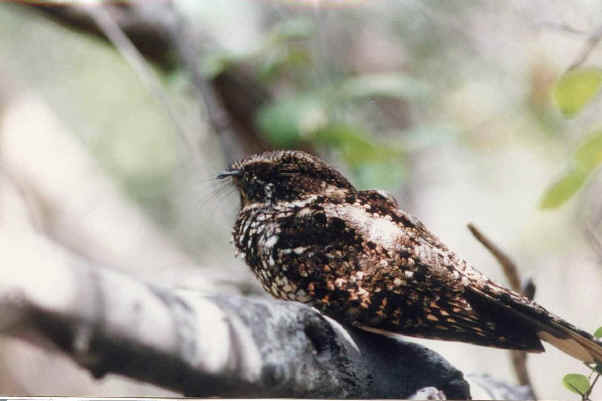
Puerto Rican Nightjar
15 GIANT KINGBIRD ______
(endemic to Cuba)
Tyrannus cubensis
16 BAHAMA SWALLOW ______ Bahamas
(endemic)
Tachycineta cyaneoviridis
17 ZAPATA WREN ______ (endemic to Cuba)
Forminia cerverai
18 LA SELLE THRUSH ______ Dominican Republic
(endemic to Hispaniola)
Turdus swalesi
The shy LaSelle Thrush was discovered in mountains in southern Haiti, known as
the Massif de la Selle, in 1927. It was not recorded elsewhere until 1971, when
it was found to be in the Bahoruco Mountains in the southwest Dominican
Republic.
In 1986, it was determined that the LaSelle Thrush population that had just recently been
found in the Central Mountains of the Dominican Republic was a different
subspecies, T. w. dodae.
The LaSelle Thrush occurs above 1300 meters above sea level in dense understory
of moist montane broadleaf forest. It is occasionally in pine forest, but only
where there is a well-grown broadleaf understory (which is rare in the pine
woods habitat of the Dominican Republic).
Even though many of the thrushes in the world in the Turdus genus are obvious,
and easy to see, the LaSelle Thrush, Turdus swalesi, is not. As noted, it is a
shy, very reclusive bird.
The bird mainly forages on the ground for earthworms, insects, and fruit.
In the mountainous Sierra de Baoruco, in the southwestern Dominican Republic,
close to Haiti, the LaSelle Thrush is restricted to isolated patches of its
preferred habitat.
In Haiti, all suitable forest may have disappeared from the species's range, and
thus the bird may be extirpated from that entire country where it was first
discovered less than 100 years ago. The LaSelle Thrush was formerly common at
the La Visite National Park in Haiti, but now its status there is unclear.
The recently-discovered race, T. w. dodae, in the western and central Dominican
Republic, occurs in the Sierra de Neiba and the Cordillera Central.
The LaSelle Thrush has been found during FONT tours in the Sierra de Baoruco
(near Haiti, and unfortunately near an area of increased human disturbance).
But, to date, it has not been found during a FONT tour in the Cordillera
Central.
19 WHITE-BREASTED THRASHER
______ Saint Lucia
Ramphocinclus brachyurus
The White-breasted Thrasher has an extremely small range and population on the
two Lesser Antillean islands of Saint Lucia and Martinique. On each island, there
is a different subspecies.
On Saint Lucia, the race R. b. santaeluciae inhabits low scrubby woodland in
ravine bottoms with dense stands of thin-trunked riparian trees. It forages on
the ground for small invertebrates, and sometimes small frogs and lizards. But
the bird only occurs in Saint Lucia on a small portion of that island (that
itself is not big!). The range on Saint Lucia is on the drier (Atlantic) side of
the island between the Marquis river valley and the Frigate Island Refuge.
In 1992, the population on Saint Lucia was said to be 46 pairs. That indicated
an annual decline of over 4 per cent in the 5 years since 1987. In 1997, the
Saint Lucian population was estimated to be just over a hundred individuals.
During that year, 1997, on Saint Lucia, nesting success was 44 per cent,
suggesting a rather normal level of nest-predation for a tropical
passerine.
However, due to predation of flightless young (on the ground) and habitat loss,
the sad decline of this very rare bird may well be continuing on Saint Lucia and
Martinique.
On Martinique, the population has been about 40 pairs on the Caravelle Peninsula.
The White-breasted Thrasher has been seen during nearly all of the 15 FONT tours
on Saint Lucia.
20 WHISTLING WARBLER
______ Saint Vincent
(endemic)
Catharopeza bishopi
The Whistling Warbler is an attractive little bird that exists only on the one
little island of Saint Vincent. And on that island, it occurs just in three
areas, where the favored habitat of the bird has been declining. The 3 areas are
the Colonaire and the Perserence Valleys, and Richmond Peak.
A total of about 2,000 singing males was estimated in 1986. Regarding the
decline of suitable habitat, just noted, it diminished from 140 square
kilometers in the early 1900's to about 80 square kilometers in 1986.
The habitat favored by the Whistling Warbler is dense undergrowth and
vine-tangles in primary rainforest, and also: palm brake, elfin forest,
secondary growth and borders. But the primary rainforest and palm brake is the
most important, holding 80 per cent of the population.
The bird is found at elevations of 300 to 1,100 meters above sea level, but
mostly below 600 meters.
Eggs are laid between April and July.
A central part of Saint Vincent was designated as a wildlife reserve in 1987,
and this protection of habitat can be a benefit to the Whistling Warbler.

The Whistling Warbler of Saint Vincent
21 YELLOW-SHOULDERED
BLACKBIRD ______ Puerto Rico
(endemic)
Agelaius x. xanthomus
(a second Puerto Rican subspecies is on Mona Island)
The Yellow-shouldered Blackbird was formerly widespread on the island of Puerto
Rico, but now it is restricted to the extreme southwest portion of the
island.
A second subspecies, Agelaius xanthomus monensis, occurs only on Mona Island, and
the smaller adjacent Monito Island, about half-way between Puerto Rico and the
Dominican Republic.
The nominate race is on the island of Puerto Rico.
There was also a
population along the far-eastern coast of Puerto Rico, But it has presumably
vanished with no breeding recorded there since 1986.
The southwest population declined by about 80 per cent between 1975 and 1981, to
a low of 300 individuals in 1982. Subsequently, roost counts during the decade
from 1985 to 1995 showed an average annual increase of 14 per cent.
In early 1998, the total population was estimated at 1,250 individuals.
Formerly, the Yellow-shouldered Blackbird occurred in mangroves, pastures,
coconut and palm stands, cactus scrub, coastal cliffs, and rarely in woodland.
It has always been found to be most common near the coast. Many birds nest on
offshore cays.
The bird forages both on the ground and in trees, feeding on insects (especially
moths and crickets), seeds, and nectar.
Birds gather communally at feeding sites, with flocks forming in the
non-breeding season.
The breeding season is from May to September, with nests are often low in
mangrove trees, or in large deciduous trees near mangroves. On Mona Island,
nests are in crevices or on ledges on high, vertical
sea-cliffs.
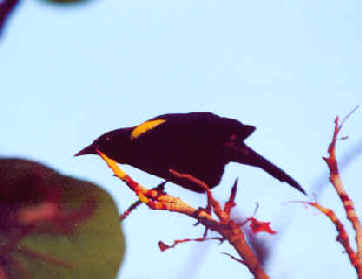
A Yellow-shouldered Blackbird photographed during a FONT Puerto Rico tour.
The rare species has been seen during all 27 of the FONT tours on the
island.
22 JAMAICAN BLACKBIRD ______ Jamaica
(endemic)
Nesopsar nigerrimus
23 CUBAN (or ZAPATA) SPARROW ______
(endemic to Cuba)
Torreornis inepectata
24 SAINT LUCIA BLACK FINCH ______ Saint Lucia
(endemic)
Melanospiza richardsoni
There is a connection between the Saint
Lucia Black Finch and the
"Darwin's Finches" of the Galapagos. At one time, it was thought that
the Saint Lucia bird was one of them.
Here's the story, taken in part from the book "Far Afield in the
Caribbean" written by Mary Wickham Bond, the wife of the ornithologist
James Bond, who specialized in West Indian birds. The just-mentioned book was
published in 1971, and in the anecdote Mrs. Bond refers to her husband, Jim.
The story (of the Saint Lucia Black Finch) began in 1835 when Charles Darwin
collected his black finches in the Galapagos Islands, a group of birds peculiar
to that archipelago. His study of them occupied him for the next 15 years, and
helped lay the basis for his "Origin of the Species".
About 50 years later, the Smithsonian Institution sent out an expedition to the
Galapagos on the steamer, the "Albatross". On the way, the expedition
stopped at several islands including Saint Lucia (in the Caribbean), where a
collection of birds was bought from a local man. Among them was a black finch
that was strikingly like the Darwin's Galapagos Finch. When asked where he got
the bird, the local man waved his hand in a vague way and said "Up in the
mountains".
However, later, it was erroneously assumed that the unusual specimen had
probably been collected in the Galapagos, and was mistakenly labeled as having
come from Saint Lucia.
In 1927, before Jim (Bond) set out on his first trip to the West Indies, he
stopped at the American Museum of Natural History in New York. Mr. De Witt
Miller, one of the older curators, said to him there, "If you get as far as
Saint Lucia be sure to look for Melanospiza (the genus of "the black
finch"). We're still not convinced that the our specimen was
collected there."
Jim spent 6 weeks on Saint Lucia and looked "everywhere" for the
finch, but didn't find it. However, later, during his second trip to the
Caribbean, he returned to Saint Lucia during the month of May, a better time to
find rare birds as it's the breeding season and they're in song.
That time, he did find it, collecting several, including the first females known
to science, from the mountainous country Soufriere.
On his return to New York, he (Bond) stopped in again at the American Museum. He
got the word of his find to Mr. Frank Chapman, the head of the museum's bird
department.
The Darwin's Finches, the most primitive of the Galapagos landbirds, have been,
over the years, the subject of many studies and publications by naturalists from
all over the world, including the eminent English ornithologist, David Lack. He
examined specimens of all the finches of North, South, and Central America, and
finding nothing like the Darwin's Finches among them, he decided they were a
distinct family. But he did not include in his studies the Antillean finches.
Had he done so, he would have noted how closely Melanospiza resembled the
Galapagos Finches.
The discovery by Jim (Bond) established the fact that Melanospiza was indigenous
to Saint Lucia, which strongly indicated that the Darwin's Finches and Melanospiza which invaded the Galapagos Islands and the West Indies, where they
survive (but in the West Indies only in Saint Lucia), through the lack of
competition with mainland species and the absence of significant predators.
Now, introduced mongooses and rats predate eggs, nestlings, and adults. A survey
in 1987 failed to find any large population, and noted that much suitable
habitat was unoccupied. At present, the species occurs mostly in the mountains.
25 HISPANIOLAN CROSSBILL
______ Dominican Republic
(endemic to Hispaniola)
Loxia megaplaga
The Hispaniolan Crossbill has been considered conspecific with
the White-winged or Two-barred, Crossbill. The bird, in the pine forests high in the mountains of
Hispaniola, has been there a long time, as far back as the Glacial Age in
Pleistocene times, about 85,000,000 years ago.
In that sense its history is long. In another, it's short. The bird was
discovered in the 20th Century, in 1916. Only 4 other species of birds on
Hispaniola were discovered in the 20th Century: the Least Poorwill, the LaSelle
Thrush, the Western Chat-Tanager, and the Hispaniolan Highland
Tanager, that's been known as the White-winged Warbler. (All of these species are included in this listing or rare
birds in the Caribbean.)
Most birds, of course, not just on Hispaniola, but throughout the World, were
known to science before the beginning of the 20th Century.
The Hispaniolan Crossbill has a very small population (with at least 4
subpopulations). Numbers fluctuate naturally.
In the Dominican Republic, the species was not recorded from about 1930 to 1970.
In that country, now, it is most often found in the Sierra de Baoruco mountains,
with occasional records in the Cordillera Central.
It is believed that numbers declined during much of the 20th Century due to
habitat loss, but by 1980 the bird was thought to be recovering. A population of
less than 1,000 individuals was estimated in 1994, but, as noted, numbers
fluctuate, depending on food supply.
In Haiti, the bird has been known from the mountainous areas of Massifs de la
Selle and de la Hotte, and a flock of 30 was noted in January 2000 at La Visite.
Interestingly, away from Hispaniola, several birds were found in the Blue
Mountains of Jamaica in the early 1970's, but never subsequently. Were they
blown there by a hurricane? So many birds of the Caribbean have to cope with
such a strong force of nature. And birds with fragile, low populations can
therefore, at times, be all the more in
jeopardy.
26 RED SISKIN ______ an
introduced species in Puerto Rico
Sporagra
(formerly Carduelis) cucullata
The population of the Red Siskin in Puerto Rico, from escaped cage
birds probably in the 1930s, has undergone lately a marked decline, and there
have been few recent records.
The following relates to the Red Siskin where it is native, and very rare, in northern South
America:
The Red Siskin, or the "Cardenalito"
as it's known in Spanish, is a rare and endangered species. The bird has been
known to occur locally in northern Colombia and northern Venezuela, and nearby
Guyana.
It was very good news for the species when, in 2003, a population of several
thousand birds was discovered in southern Guyana, about a thousand kilometers
from any previously known population. Otherwise, the global population of the
species in the wild has been estimated to be from 600 to 6,000 pairs.
In the early 20th Century, the Red Siskin was common in the foothills of
northern Venezuela, but later in the 1900s it became extremely rare there in a
fragmented range.
The preferred habitats of the Red Siskin are open country, forest edges,
and grasslands with trees or shrubs.
Red Siskins are highly gregarious. When they were more numerous, they
formed semi-nomadic flocks.
The main reason for the decline of the Red Siskin has been massive
illegal trapping for the cage bird trade. Being an attractive finch with a
pleasant song is against it, and its unique coloration for a small finch that
has enabled it to be used for interbreeding with domesticated Canaries to
produce varieties with red in the plumage.
27 EASTERN CHAT-TANAGER ______ Dominican
Republic (endemic)
Calyptophilus frugivorus
The Eastern Chat-Tanager was seen during the
FONT Dominican Republic Tour in February 2012, in the mountains of the
Cordillera Central.
That subspecies, Calyptophilus frugivorus neibei, occurs uncommonly and
locally in the Cordillera Central and Sierra de Neiba mountains in the central
Dominican Republic.
Two other subspecies of the Eastern Chat-Tanager have occurred, on the Semana Peninsula
in the northeastern Dominican Republic and on Gonave Island in Haiti, but
neither of them have not been found in decades. Those subspecies are
respectively, C. f. frugivorus &
C. f. abbotti.
In the 2000 edition of Birdlife International's "Threatened Birds of the
World" it was written the "much needed redefinition of the taxonomic
status of the Chat-Tanager would almost certainly result in a significant change
of the bird's 'vulnerable' classification". Since then (and reflected
here), some taxonomic revision has been done, and the Eastern Chat-Tanager
has been classified as "endangered", while the Western Chat-Tanager remains
"vulnerable".
In the book, "Birds of the Dominican Republic and Haiti",
published in 2006, the Eastern Chat-Tanager was categorized as
"critically endangered".
Birdlife International, still as of 2012, categorized the species as "vulnerable",
as they question the split of the Western Chat-Tanager from the Eastern
Chat-Tanager, and collectively they consider the bird as the "Chat-Tanager".
In our view, we note the Western Chat-Tanager as "vulnerable"
(below), and the Eastern Chat-Tanager here as at least "endangered",
although the assessment of the authors of the 2006 field guide may be
correct.
The nominate of the Eastern Chat-Tanager was described back in the 19th Century,
in 1883.
The race on Gonave Island was described in 1924.
And, most recently,
the subspecies that is still known to exist today, C. f. neibei, was described
only as recently as 1977.
See also the text that follows with the WESTERN CHAT-TANAGER
(among the
species in the "vulnerable"
category)
Species in the Caribbean classified as VULNERABLE:
28 WEST INDIAN WHISTLING DUCK
______ Barbuda, Cayman Islands, Dominican Republic,
Jamaica, Puerto Rico
Dendrocygna arborea
The West Indian Whistling Duck occurs only on various West Indian
islands, where its range is extremely fragmented.
Whereas its remaining habitat has been declining, and the West Indian
Whistling Duck has disappeared from some sites where it has been, there
seems recently to have been an overall slight increase in the bird's population.
The duck is generally crepuscular or nocturnal, and often
secretive.
During FONT Caribbean Tours, the West Indian Whistling Duck has been seen on 5 islands
as noted above.
Some recent information about the approximate, or estimated populations of the West
Indian Whistling Duck on various islands is as follows:
Barbuda: 50 birds (with maybe 500 in nearby Antigua)
Cayman Islands: from 800 to 1,200 birds
Dominican Republic: apparently 6 populations, the number of birds unknown
Jamaica: 500 birds
Puerto Rico: perhaps 100 birds
At least 1,500 birds are said to exist in the Bahamas.
On January 6, 2001, a pair of
West Indian Whistling Ducks with 3 chicks marked the first nesting record
for the species on Abaco Island in the Bahamas.
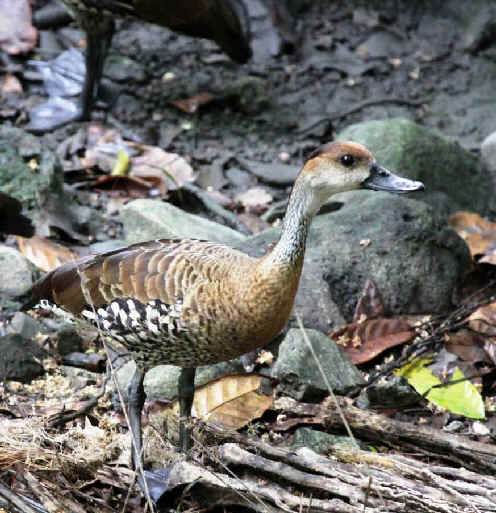
A West Indian Whistling Duck
photographed during a FONT tour
in the Dominican Republic
(photo by Marie Gardner)
29 RING-TAILED PIGEON ______ Jamaica
(endemic)
Patagioenas
(formerly
Columba)
caribaea
30 WHITE-FRONTED QUAIL-DOVE ______ Dominican Republic
(endemic)
Geotrygon leucometopius
The White-fronted Quail-Dove was considered conspecific with the Gray-headed Quail-Dove (below).
31 GRAY-HEADED QUAIL-DOVE ______
(endemic to Cuba)
Geotrygon caniceps
32
HISPANIOLAN PARAKEET
______ Dominican Republic
(endemic to Hispaniola)
Aratinga chloroptera
The Hispaniolan Parakeet has a small and fragmented range and population, which
continues to decline due to persecution.
Overall on the island of Hispaniola, the bird is rare with isolated populations
in the Dominican Republic, in the Cordillera Central, the Sierra de Baoruco, and
in some neighborhoods on the western side of the city of Santo Domingo.
The
current status of the bird in Haiti is unclear. It has been suggested that it is
extinct there, there have been claims that it is in the Massif de la Selle and
la Citadelle area of the Massif du Nord. (It should be noted that the
Jamaican
(formerly Olive-throated) Parakeet occurs now in western Hispaniola.)
A race of the Hispaniolan Parakeet, Aratinga chloroptera maugei, has become
extinct. It formerly occurred on Mona Island, Puerto Rico (about halfway between
the Dominican Republic and the island of Puerto Rico).
There is a feral population of the Hispaniolan Parakeet in Puerto Rico, and
possibly on the Lesser Antillean island of Guadeloupe.
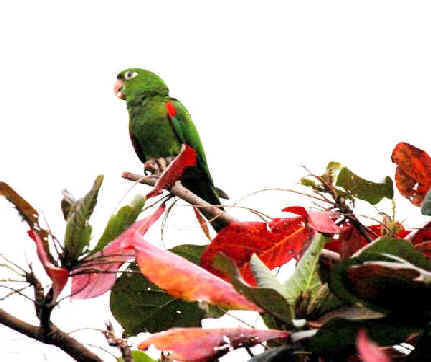
A Hispaniolan Parakeet photographed during a FONT
tour
(photo by Marie Gardner)
33 HISPANIOLAN AMAZON
(or
Hispaniolan Parrot) ______ Dominican Republic
(endemic to Hispaniola)
Amazona ventralis
The Hispaniolan Amazon (or Hispaniolan Parrot) was common on the island of Hispaniola, but it declined
seriously during the 20th Century. By the 1930's. it was mainly restricted to
the mountains in the central and southwestern Dominican Republic and in western
Haiti, where it still remains locally common. Recent evidence, however, has
suggested that there has been, as of late, a rapid population reduction. But the
current extent of the decline, and the present population of the species is
unclear.
The bird inhabits a variety of wooded habitats, from arid palm-savannas to pine
and montane humid forests, occurring as high as 1500 meters (4500 feet) above
sea level. It frequently forages in cultivated lands, such as banana plantations
and corn fields. Nesting is known to take place from February to May, maybe
later,
Introduced Hispaniolan Amazons are established in Puerto Rico, and in the Virgin
Islands on St. Croix and St, Thomas. The population in Puerto Rico is several
hundred birds, and is apparently increasing.
34 YELLOW-BILLED AMAZON ______ Jamaica
(endemic)
Amazona collaria
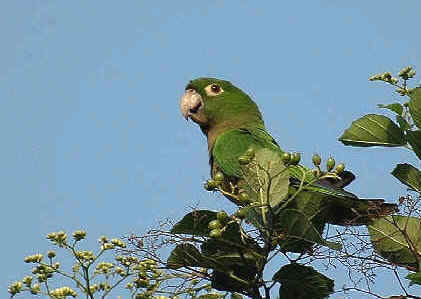
Yellow-billed Amazon
(photo by Suzanne Bradley)
35 BLACK-BILLED AMAZON
______
Jamaica
(endemic)
Amazona agilis
36 RED-NECKED AMAZON (or Red-necked
Parrot) (the "Jaco")
______ Dominica
(endemic)
Amazona arausiaca
During recent decades, the Red-necked Amazon, or Red-necked Parrot, has done a bit better than the
other amazon that inhabits the same area of Dominica, the Imperial Amazon (see
above, under "endangered").
The population of the Red-necked Amazon is a few hundred birds.
Both the Red-necked and Imperial Amazons, however, are quite vulnerable to
disasters such a direct hit by a powerful hurricane. Actually, the number of Red-necked
Amazons was halved by such events in 1979 and 1980.
37 SAINT LUCIA AMAZON
(the "Jacquot")
______ Saint Lucia (endemic)
Amazona versicolor
The Saint Lucia Amazon, when seen well, is a beautiful parrot. It is an
overall green bird, with a iridescent blue face and a scalloped black and red
breast. In 1950, its population was believed to be about 1,000 birds. A survey
in 1978 estimated that only about 100 birds continued to exist. During those 25
or so years, suitable habitat reduced rapidly.
After the 1970's, diligent conservation efforts saved the species from
extinction. A survey in 1996 estimated the wild population to be between 350 and
500 individuals, and it noted some slight range expansion.
However, the human population on the island of Saint Lucia is growing at a
considerable rate, and there is increasing pressure on the forest resulting
lately in some habitat loss. So, the area of apparently suitable habitat
(unoccupied by parrots) may now be decreasing, and if this begins to affect the
suitable habitat that is currently occupied by parrots, the status of the bird
would need to be changed from "vulnerable" to "endangered",
as the species does have such a small range in which an appropriate habitat is
required.
38 SAINT VINCENT AMAZON ______ Saint Vincent
(endemic)
Amazona guildingii
The Saint Vincent Amazon is really quite a bird. It occurs in two general color
schemes, brownish or greenish. Both are striking birds with white on their
heads, blue on their faces, and bright yellow in their wings and tails.
In the early 1970's, there were an estimated 1,000 of these birds. By the late
1980's, the total population was said to be about half of that.
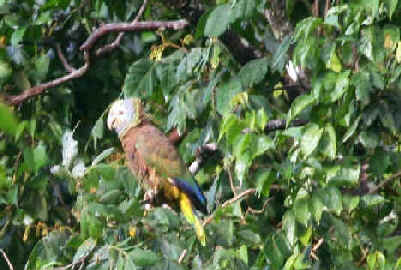
A Saint Vincent Amazon in the wild,
photographed during the Dec 2007 FONT Tour in the Lesser Antilles.
(photo by Marie Gardner)
39 YELLOW-SHOULDERED AMAZON ______
in the Netherlands Antilles (and the coast & offshore islands of
Venezuela)
Amazona barbadensis
In the Netherlands Antilles, the Yellow-shouldered Amazon occurs
mostly on the island of Bonaire where in 2012 there were said to be over
600 birds.
On Curacao, there have been modern-day reports of parrots since 1988.
Historically, there was a parrot population on Curacao in the 18th century.
Amazona barbadensis formerly occurred
on Aruba, but it has been extirpated on that island.
40 FERNANDINA'S FLICKER ______
(endemic to
Cuba)
Colaptes fernandinae
41 WHITE-NECKED CROW
______ Dominican Republic (now
endemic to Hispaniola)
Corvus leucognaphalus
The White-necked Crow is now endemic to Hispaniola. It formerly occurred on Puerto
Rico, bur it was last recorded there
in 1963.
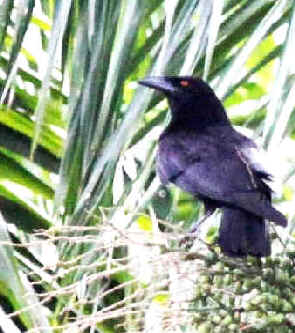
A White-necked Crow photographed during a FONT tour
(photo by Marie Gardner)
42 GOLDEN SWALLOW ______
Dominican Republic (now seemingly endemic
to Hispaniola)
Tachycineta euchrysea sclateri
The endemic subspecies of the Golden Swallow on the island of Hispaniola,
Tachycineta euchrysea sclateri, has a small, fragmented, and declining
population. It may now be that the population on Hispaniola is an endemic
species, as the nominate subspecies in Jamaica has not been recorded there in
years.
In Jamaica, the Golden Swallow has been (or was) very rare and local, where it
has been observed from the Cockpit Country east across the central highlands to
the Blue Mountains. The Jamaican population was said to be common in the 19th
Century.
In Hispaniola, it occurs in the Cordillera Central and the Sierra de Baoruco in
the Dominican Republic, and in the Massif de la Selle in Haiti.
Overall, the species suffered a massive decline during much of the 20th Century.
The Golden Swallow in Hispaniola favors montane humid and pine forests, from
about 800 to 2,000 meters (2,400 to 6,000 feet) above sea level. Nests are in
old woodpecker and other holes in dead pines, and have also been noted in caves,
boulders in an old bauxite mine, and in the eaves of buildings. It flies about,
either singly or in small groups, feeding on small insects.
The common English name, Golden Swallow, comes from the sheen on its back, when
the bird is seen in good sunlight from above (sometimes hard to do with a
swallow)
43 FOREST THRUSH ______ Dominica
Turdus
(formerly
Cichlherminia)
iherminieri dominicensis
The Forest Thrush has 4 subspecies. In
addition to the subspecies endemic to the island of Dominica, there are other
endemic subspecies on the islands of Guadeloupe and Montserrat, and possibly
still on Saint Lucia, where, if it still occurs, it is very rare.
Throughout its range, this species has declined significantly in recent years,
due in part to deforestation and introduced predators. The bird can be
exceedingly shy where it has been hunted (another factor in its decline).
In Montserrat, its population was reduced by two-thirds in 1995-1997 due to
effects from a major volcanic eruption, but since then, on that island, there
has been an increase. In December 1999, on Montserrat, the population was
estimated to be just over 3,000 birds.
Threats, throughout its range, have been brood-parasitism by Shiny Cowbirds and
competition with the Spectacled (formerly Bare-eyed) Thrush.
On the French island of Guadeloupe, the Forest Thrush still continues to be
legally hunted. On Dominica, it occurs in the Morne Diablotin National Park, and
in other similar forested locations.
On Saint Lucia, the bird is said to have formerly gathered in large numbers in
autumn to feed on berries.
44 BICKNELL'S THRUSH
______
Dominican Republic
Catharus bicknelli
The wintering range of the Bicknell's Thrush is restricted to the
Greater Antilles of the West Indies, on the islands of Hispaniola, Cuba,
Jamaica, and Puerto Rico.
However, most, by far, winter in the Dominican Republic on Hispaniola.
The Bicknell's Thrush, in its wintering territory, is typically shy and
wary. It searches for invertebrates and fruits on the ground or in the
sub-canopy of moist broadleaf forest, or broadleaf forest with few pines mixed
in. The bird prefers dense understory.
Surveys conducted in the 1990s in the Dominican Republic found the following
regarding the Bicknell's Thrush occurring as a seasonal non-breeding
resident:
75 per cent in wet and mesic broadleaf forests
19 per cent in mixed pine/broadleaf forests
6 per cent in pine-dominated forests.
Birds were found at all elevations from sea level to 6,600 feet above sea level.
Most, that is 62 per cent, were in primary montane forests higher that 3,000
feet in elevation.
In its migration, the Bicknell's Thrush can be found at some
lowland localities in the Dominican Republic.
During surveys in the Dominican Republic in the 1990s & the early 2000s,
places in high elevations where the Bicknell's Thrush was found included:
Sierras de Bahoruco, Neiba, and Martin Garcia, and the Cordilleras Central,
Septentrional, and Oriental. It is most common in the Sierra de Bahoruco and the
Cordillera Central.
Other places included the Los Haitises National Park and less so in the Del Este
National Park.
The surveys seem to have found some sexual segregation among birds wintering in
the Dominican Republic with males mostly in undisturbed montane forests, while
females and birds of the year in younger, or more disturbed
forests.
The arrival of Bicknell's Thrushes in the Dominican Republic is thought
to be in late October and early November.
The birds probably start their northward spring migration in early to
mid-April.
45 ELFIN WOODS WARBLER ______ Puerto Rico
(endemic)
Setophaga
(formerly Dendroica) angelae
It was as recently as 1971 that the Elfin Woods Warbler was discovered. Endemic
to Puerto Rico, it is uncommon and local in 4 disjunct areas of the island. In
the east, it is in the Sierra de Luquillo (in the Caribbean National Forest) and
in the Sierra de Cayey (in the Carite Forest). In the west, in the Cordillera
Central (in the Maricao & Toro Negro Forests). The total population, at
these localities where the bird is known, has been estimated at no more than 300
pairs.
As indicated by its name, the bird inhabits elfin, or montane dwarf, forest on
ridges and summits, and montane wet forest. Preferred areas have a dense canopy
with vines, high sub-canopy and sparse understory. Although it has been found in
secondary habitats, it occurs most in undisturbed forest. Breeding takes place
from March to June.
By the late 1940's, the natural vegetation of Puerto Rico had been reduced to
about 6 per cent of the island's land surface, but a later regeneration of
forest increased the figure to about 30 per cent in the early 1980's.
46 CERULEAN WARBLER ______ a
migrant in the West Indies
Setophaga (formerly Dendroica) cerulea
47 HISPANIOLAN HIGHLAND TANAGER
(has been called White-winged Warbler) ______
Dominican Republic
(endemic)
Xenoligea montana
The Hispaniolan Highlands Tanager (that has also been known as the White-winged
Warbler) was one of
the four Hispaniolan birds discovered in the 20th Century.
When it was
described, in 1917, it was given the scientific name Microlgea
montana. It
occurs high in the "montanas" (or mountains). In 1967, the bird became
the single member of its genus, and the new scientific name given to it at that
time was Xenoligea montana.
48 WESTERN CHAT-TANAGER ______ Dominican Republic
(endemic to Hispaniola)
Calyptophilus tertius
The bird currently called the Western Chat-Tanager has been considered a
subspecies of the Eastern Chat-Tanager, Calyptophilus frugivorus, but
it is now said by some to be a distinct species.
The Western Chat-Tanager, with a length of 8 inches, is just over an inch larger
than the Eastern Chat-Tanager at 6.75 inches, and it lacks the bare yellow
eye-ring of the Eastern Chat-Tanager. The voices of the two Chat-Tanagers are
noticeably different.
The local name of the Western Chat-Tanager is "El Chirri". That of the
Eastern Chat-Tanager (the race in the central Dominican Republic) is "El
Patico".
The Western Chat-Tanager, Calyptophilus tertius, occurs in southwestern
Hispaniola in Haiti and the adjacent Dominican Republic, where it is local in
the Sierra de Baoruco mountains.
The Eastern Chat-Tanager, Calyptophilus frugivorus neibei, occurs uncommonly and
locally in the Cordillera Central and Sierra de Neiba mountains in the central
Dominican Republic.
Two other subspecies have occurred, on the Semana Peninsula
in the northeastern Dominican Republic and on Gonave Island in Haiti, but
neither of them have not been found in decades. Those subspecies are
respectively, C. f. frugivorus &
C. f. abbotti.
In the 2000 edition of Birdlife International's "Threatened Birds of the
World" it was written the "much needed redefinition of the taxonomic
status of the Chat-Tanager would almost certainly result in a significant change
of the bird's 'vulnerable' classification". Since then (and reflected
here), some taxonomic revision has been done, and the Eastern Chat-Tanager
has been classified as "endangered", while the Western Chat-Tanager remains
"vulnerable".
The nominate of the Eastern Chat-Tanager was described back in the 19th Century,
in 1883.
The race on Gonave Island was described in 1924.
And, most recently,
the subspecies that is still known to exist today, C. f. neibei, was described
only as recently as 1977.
What is now the Western Chat-Tanager was described in 1929 (first as a
subspecies), making it now the last of the birds of the Dominican Republic (at
least, to date) to be described.
As noted here elsewhere, 4 other species of
birds in the Dominican Republic were described in the 20th Century: the Hispaniolan
Crossbill in 1916, the Least Poorwill and the Hispaniolan Highlands
Tanager in 1917, and the La Selle Thrush in 1927. A second subspecies of the last
of these, the thrush, was found in the Central Mountains of the Dominican
Republic as recently as 1986.
The speciation of the two Chat-Tanagers is said to have most likely occurred
when present-day Hispaniola consisted of two separate islands.
The Chat-Tanagers are largely terrestrial in broadleaf forests and dense
thickets, and they particularly favor ravines. The two species, C. tertius &
C. frugivorus neibei, are primarily montane. They feed chiefly, near the ground,
on invertebrates, rather than on fruits as implied by the scientific name "frugivorus".
Even though the Western Chat-Tanager is one of the finest of Hispaniola's avian
songsters, the bird can be notoriously hard to see, being an adept skulker.
That
notwithstanding, during the FONT Dominican Republic tour in April 2008, the Western
Chat-Tanager was both heard & seen very well - so much so, that it
was voted the "top bird" of the tour! (And it might well be noted that
the bird was seen well because of its own activity, and not due to a response to
a tape).
Apparently, in the remote area where we were, the birds had a nest near
the road. One of them, at least, was seen repeatedly flying across the road, and
perching, not high, on a nearby branch. So many times, in the past, we only had
a glimpse of the bird. After all, there is a reason why it was described as late
as
1929.
Species in the Caribbean classified as NEAR-THREATENED:
49 BLACK RAIL ______
Laterallus jamaicensis
50 CARIBBEAN COOT ______ Dominican Republic,
Jamaica, Puerto Rico, Saint Lucia
Fulica caribaea
The Caribbean Coot has been said by some to be conspecific with the American Coot,
F. americana.
51 PIPING PLOVER ______
Charadrius melodus
52 BUFF-BREASTED SANDPIPER ______ a southbound migrant in
the West Indies, in the late-summer & early-fall
Tryngites subruficollis
53 WHITE-CROWNED PIGEON ______ Antigua,
Cayman Islands, Dominican Republic, Jamaica, Puerto Rico
Patagioenas (formerly Columba)
leucocephala
54 PLAIN PIGEON ______ Dominican Republic,
Puerto Rico
Patagioenas (formerly Columba) inornata
55 CRESTED QUAIL-DOVE (the
"Mountain Witch")
______ Jamaica (endemic)
Geotrygon versicolor
56 ROSE-THROATED AMAZON
______ Cayman Islands
Amazona leucocephala
This species has various names on different Caribbean islands.
It's known as the Bahama, the Cuban
and the Cayman Islands Amazon, or Parrot
There are 5 subspecies, 2 in Cuba, 1 in the Bahamas, and 2 in the Caymans:
A. l. caymanensis, ______ Grand Cayman, in the Cayman Islands
(endemic
subspecies)
A. 1. hesterna, ______ Cayman Brac Is., in the Cayman
Islands (endemic subspecies)
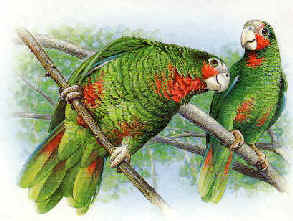
The Rose-throated Amazon, or the Cayman Islands Amazon,
a species always seen during FONT tours on those islands.
57 LEAST POORWILL ______
Dominican Republic
(endemic)
Siphonorhis brewsteri
The Least Poorwill had, for a while, a scanty history, after the first specimen
was collected in 1917. At that time, the small nightjar, that has also been
called the Least Pauraque, was given the scientific name Microsiphonorhis
brewsteri. The genus was changed in 1928 to Siphonorhis.
From that year, until 1969, there were very few, if any, reports of this bird,
that locally is called "El Torico".
The nice thing is that today this species of Siphonorhis can still be found (as
it is during our tours). The only other member of the genus, Siphonorhis
americana, the Jamaican Poorwill (or "Jamaican Pauraque"), is now
believed to be extinct.
The Least Poorwill is a small bird, with a length as little as just over 6
inches. In western North America, the Common Poorwill is about an inch to two
inches longer.
And, as a frame of reference, the familiar American Robin has a
length of about 10 inches.
Reasons why this small nightjar escaped detection for almost 50 years in the
20th Century are that the bird is entirely nocturnal, and that it lives in dense
vegetation in areas of cactus and thorn scrub where, in general, not many people
penetrate. Its distribution is local. Where it occurs, it may be relatively
common, but overall it is not.
We have found that, during FONT tours, at an appropriate place, the Least
Poorwill can begin calling at dusk, and that when (if) it responds to a tape, it
can fly by quickly, close to the ground, like a 6-inch dart.
It's written that the downy young of the Least Poorwill looks like a fluffy ball
of white cotton, and that it appears to mimic a round whitish cactus which grows
where the bird nests. Actually, the first nestling was discovered by a botanist
collecting cacti. The bird was thought to be a cactus until it moved.
58 BEE HUMMINGBIRD ______ (endemic to Cuba)
Mellisvea helenae
The Bee Hummingbird is said to be the smallest of all
birds.
59 HISPANIOLAN TROGON
______ Dominican Republic
(endemic to Hispaniola)
Priotelus roseigaster
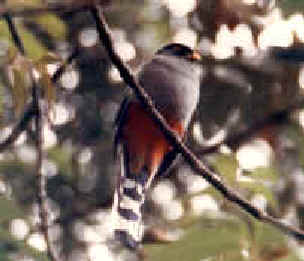
A Hispaniolan Trogon photographed during a FONT tour in the Dominican Republic.
The species has been found during all 19 FONT tours on that island.
60 GUADELOUPE WOODPECKER
______ Guadeloupe
(endemic)
Melanerpes herminieri
Geographically Isolated, from away from any other woodpecker, the Guadeloupe
Woodpecker is endemic to that one island in the Lesser Antilles.
Guadeloupe is an overseas prefect of France. It has 2 senators and 3 deputies in
the French parliament in Paris. The license plates on the mostly small vehicles
are as those in France. The money is as that in France, the Euro. Of the
thousands of tourists who visit Guadeloupe each year, mostly for its beaches,
far and away the most are from France.
So it is not surprising that the Guadeloupe Woodpecker has a French name,
the "Tapeur". It is from "taper" meaning "to
tap", or "to strike, bang, or beat".
Of the more than 200 species of woodpeckers in the world, there are things about
the "Tapeur" that set it apart from the others.
It has a reddish-purple breast and belly, but often the bird appears all-black.
In flight, the bird does not undulate as woodpeckers normally do.
Its call is also distinctively its own, a loud "ch-arrgh" given by
birds in the forest to maintain contact with each other.
Oddly, the closest woodpecker to it, in terms of appearance and structure, is
the Lewis' Woodpecker of western North America. It is in the same genus
as the Lewis', Melanerpes.
But the Guadeloupe Woodpecker is so geographically isolated from others
in the woodpecker family. There are also Melanerpes
woodpeckers in the Greater Antilles and in Central and South America, but
there is no other woodpecker of any kind in the Lesser Antilles.
The "Tapeur" is a rather shy, and often
inconspicuous bird of the dense forest and other wooded habitats.
It occurs below 1,000 feet above sea level.
It is estimated that its population may be 10,000 pairs.
The bird does not "flycatch". Its diet of insects is taken in dead
wood.
A particularly interesting aspect of Melanerpes
hermionieri, the Guadeloupe Woodpecker, is that the length
of the male's bill is 20 per cent longer that that of the female.
During our FONT tours in Guadeloupe, we have been fortunate to see pairs,
together, in bare trees, and that notable difference in bill length could easily
be seen.
61 HISPANIOLAN PALM CROW ______ Dominican Republic
(now a subspecies endemic to Hispaniola)
Corvus p. palmarum
The Hispaniolan Palm Crow has been split from the "Cuban
Pam Crow", Corvus palmarum minutus,
but now the two are considered conspecific.
62 BLUE MOUNTAIN VIREO ______ Jamaica
(endemic)
Vireo osburni
63 CUBAN SOLITAIRE ______ (endemic to Cuba)
Myadestes elisabeth
64 GOLDEN-WINGED WARBLER ______
a migrant in the West Indies
![]()
Regarding SUBSPECIES:
Some Subspecies
in the Caribbean classified as ENDANGERED:
SHARP-SHINNED HAWK ______ Puerto Rico
(endemic)
Accipiter striatus venator
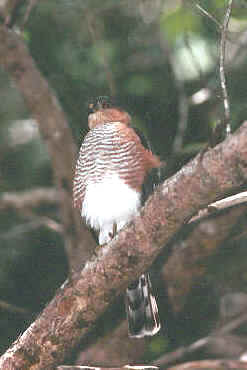
The subspecies of the Sharp-shinned Hawk
in Puerto Rico
BROAD-WINGED HAWK ______ Antigua
(endemic)
Buteo platypterus insulicola
There are 5 subspecies of the Broad-winged Hawk on West Indian islands.
All of them are residents, never coming in contact with those of the same
species in eastern North America, Buteo p.
platypterus.
The resident Caribbean subspecies occur in Cuba, Puerto Rico (below), and
in the Lesser Antilles with B. p. rivierei on
Dominica, Martinique, and St, Lucia, and B. p.
antillarum on St. Vincent, Grenada, Barbados, and Tobago.
The fifth Caribbean subspecies, Buteo platypterus
insulicola, on Antigua, has the smallest range of any of the
subspecies, being endemic to just that one small island.
The bird on Antigua is said to be smaller and lighter than any other subspecies
of Broad-winged Hawk.
The subspecies of the Broad-winged Hawk on Antigua is the only bird
endemic to that island.
STYGIAN OWL ______ Dominican
Republic
Asio stygius noctipetens
The subspecies of the Stygian Owl on Hispaniola,
A. s. noctipetens, is said to be
smaller and with whiter markings than other subspecies in Central and South
America.
On Hispaniola, the Stygian Owl is a very rare breeding resident in dense
deciduous and pine forests in remote areas.
In recent years, all of the localities where it has been found are in remote old
forests, sometimes near caves or in wooded ravines, and not near human dwellings
or in second-growth habitats.
Since the mid-1980s, the Stygian Owl has been found sporadically in the
pine forests of the Cordillera Central, on the Samana Peninsula, in the Los
Haitises National Park, and in the Sierra de Bahoruco. It also occurs on the Ile
de Gonave.
"SAINT LUCIA" RUFOUS NIGHTJAR ______ Saint Lucia
(endemic)
Caprimulgus rufus otiosus
SHARP-SHINNED HAWK ______ Dominican Republic
(endemic)
Accipiter s. striatus
BROAD-WINGED HAWK ______ Puerto Rico
(endemic)
Buteo platypterus brunnescens
LIMPKIN ______ Dominican Republic
(where
now endemic, as it has been extirpated in Puerto Rico)
Aramus guarauna elucus
DOUBLE-STRIPED THICK-KNEE ______ Dominican
Republic
Burhinus bistriatus
SNOWY PLOVER ______ Dominican Republic, Puerto Rico
Charadrius alexandrinus nivosus
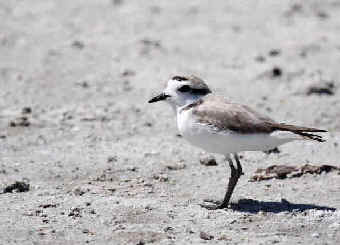
A Snowy Plover photographed during a FONT tour
in the Dominican Republic
(photo by Marie Gardner)
ROSEATE TERN ______ Dominican Republic, Puerto
Rico, St. Lucia
Sterna d. dougallii
"SAINT LUCIA WREN" ______ Saint Lucia
(endemic)
Troglodytes aedon mesoleucus
The subspecies of the House Wren on nearby Martinique has been
extirpated.
"SAINT VINCENT WREN" ______ Saint Vincent
(endemic)
Troglodytes aedon musicus
![]()
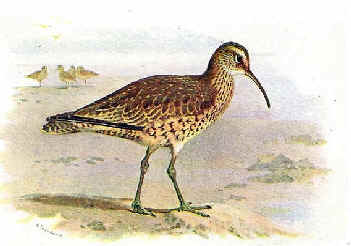
A painting of an Eskimo Curlew by Archibald Thorbum
Another name for the Eskimo Curlew was the "Doe-bird",
sometimes spelled "Dough-bird". That name was due to the bird's
acquiring of fatness for its long journey south.
As North America was being settled by the Europeans, the Eskimo Curlew
was one of the most abundant birds on the continent.
It bred on the Barren Grounds of northern Canada. It wintered in
far-southern South America. It migrated in between.
It was said, during its southbound migration, to have visited Newfoundland
"in millions" darkening the sky.
John James Audubon, Elliot Coues, and other ornithologists of the early 1800s
told of immense flights.
In the Prairie States, the numbers of Eskimo Curlews so resembled
the tremendous flights of Passenger Pigeons that they were called
"Prairie Pigeons".
A single flock alighting in Nebraska was said to have covered 40 to 50
acres of ground.
The Eskimo Curlew migrated south in August southeast to Labrador and
Newfoundland, where they fed on "curlew berries" (Empetrum
nigrum) and snails, gaining the weight needed for their long journey out over
the sea to South America.
Easterly storms, such as hurricanes that time of year, sometimes brought them
onto the coasts of New England and Long Island, New York.
They often touched down on Lesser Antillean islands, such as Barbados,
before continuing on to to the coast of Brazil, and then further to Argentina.
During their northbound spring route, after crossing the Gulf of Mexico, they
arrived in March in southern Texas, and then continued up the western
Mississippi Valley, and thence further north to where they would nest.
But from being abundant, the status of the Eskimo Curlew
in the 19th Century certainly changed.
Incredibly, the Eskimo Curlew was not seen anywhere at its known breeding
grounds for years after 1865.
Just over a century later, in 1987, a small nesting colony was said to be found
in the Canadian Arctic, that was maybe the last.
The last breeding grounds of the Eskimo Curlew in northern Canada are
said to have been in either Ungava or Franklin.
The last Eskimo Curlews were either seen or shot at these places as
follows:
in Illinois in 1872
in Ontario in 1873
in Ohio in 1878
in Arkansas and Michigan in 1883
in South Dakota and Oklahoma in 1884
in Minnesota in 1885
in Louisiana, Pennsylvania, and Newfoundland in 1889
in Indiana in 1890
in Iowa in 1893
in Prince Edward Island in 1901
in Kansas, Missouri, and Nova Scotia in 1902
in Quebec in 1906 (fair-sized flocks in the fall were in Quebec
until 1891)
in Wisconsin in 1912
in Maryland, and Bermuda in 1913 (fair-sized flocks were in Bermuda
until 1874)
in Massachusetts in 1916 (fair-sized flocks were in Massachusetts
until 1883)
in Nebraska in 1926 (there was a more-recent report in Nebraska in
1987)
in Maine in 1929 (fair-sized flocks were in Maine until
1879)
in Labrador and Long Island, New York in 1932 (fair-sized flocks
in the fall were in Labrador until 1892)
in South Carolina in 1956
in New Jersey in 1959
in the Bahamas in 1963
in Barbados in the Lesser Antilles in 1964, when one was shot.
No spring migrant was seen anywhere other than Texas since 1926.
Along the Gulf coast of Texas, the last confirmed sighting, with a
photograph, was at Galveston in 1962. A flock of 23 birds was reported there in
1981.
There were additional, but unconfirmed records of Eskimo Curlews:
in Texas and Canada in 1987 (the Canadian "breeding
site" noted above), in Nova Scotia in 2006, and in Argentina
in 1990.
The last Eskimo Curlews seen and confirmed at wintering grounds in South
America, were in Argentina back in n 1939.
With prevailing westerlies or strong storms, Eskimo Curlews were at times
seen across the Atlantic Ocean:
Sighted or shot:
in England in 1852 (2 birds) and 1887.
in Scotland in 1855, 1878, 1880.
in Ireland in 1870.
CUBAN, or
HISPANIOLAN RED, MACAW
______
Cuba
(from where specimens were
obtained)
& Hispaniola
(no specimens)
Ara tricolor
The last known occurrence of a Cuban (or Hispaniolan) Red
Macaw, Ara
tricolor, was when a single wild bird was shot in the area of the Zapata Swamp
in Cuba in 1864. Probably a few birds survived beyond that, until about 1885.
Cory, at about that time, wrote: "Dr. Gundlach writes me that he believes
it still occurs in the swamps of southern Cuba".
A few years earlier,
Gundlach noted that in 1849 it could easily be found.
In the 1850s, the last
flock came regularly to feed in a small group of trees at Zarabanda, also in the
Zapata Swamp area of Cuba.
The Cuban (or Hispaniolan) Red Macaw was similar to the
Scarlet Macaw of Central
& South America, but smaller (about 20 inches in length). It had a red
breast and brow, a yellow crown and neck, dark blue wings, and a long tail that
was blue above and red below.
The bird nested in holes and clefts in palm trees, and favored those palms and
the flowering Melia trees for their diet of fruit, seeds, sprouts, and buds.
It's been noted that on occasion the Cuban people killed the macaws for food,
and that they captured them, usually in their nests, to be pets.
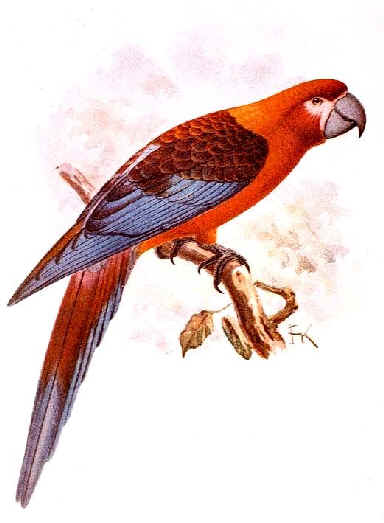
The Hispaniolan, or Cuban Red Macaw,
now extinct
There is historical reference to a red macaw, also, on the Caribbean island of
Hispaniola (now thought to be the same species as in Cuba).
In a study in 1985, it was concluded that the origins of Ara tricolor
were on Hispaniola,
not Cuba. On the basis of old descriptions, it's said that the macaws on
Hispaniola could have been a separate subspecies, with a smaller bill, and some
minor plumage differences such as a white forehead, rather than red as on the
Cuban bird.
No specimens now exist from Hispaniola, but there are still, throughout the
world, 19 specimens of the macaws from Cuba, in various museums including those
in: Havana, New York, Washington, Cambridge, Mass., London, Liverpool, Paris,
Vienna, Berlin, Dresden, Leyden, Stockholm, and Tring.
This species of macaw may also have occurred, historically, on Jamaica, as
"a red macaw" was reportedly shot there in 1765. Unfortunately, that
skin was lost. That bird is the first of those listed below.
There seems also to have been some other such macaws, without remaining
evidence, on some other West Indian islands: Guadeloupe, St. Croix, and St.
Vincent.
"Yellow-headed Macaw" ______ Jamaica (endemic?, as either a subspecies
or a species )
Ara (tricolor) gossei (last known
in 1765)
Green-and-Yellow Macaw ______
Jamaica (e)
Ara erythrocephala (last known in
1842)
Dominican Macaw ______
Dominica (e)
Ara atwoodi (last known in 1800)
Labat's Parakeet (or Conure) ______
Guadeloupe (e)
Aratinga labati (last known in
1722)
Guadeloupe Amazon (or Parrot) ______
Guadeloupe (e)
Amazona violacea (last known in
1750)
Martinique Amazon (or Parrot) ______
Martinique (e)
Amazona martinica (last known
1750)
JAMAICAN POORWILL ______ Jamaica (e)
Siphonorhis americanus
(last known in 1859)
Siphonorhis americanus has also been called
Jamaican Pauraque.
BRACE'S HUMMINGBIRD ______ Bahamas
Chlorostilbon bracei
The Brace's Hummingbird is known only from one specimen collected in
1877.
"CUBAN IVORY-BILLED WOODPECKER" ______
Cuba
Campephilus (principalis) bairdii (endemic to Cuba)
Recent DNA evidence (published in 2006) indicates that what has been said
to be a subspecies of the Ivory-billed Woodpecker in Cuba, Campephilus (principalis)
bairdii, is (was) not.
First described in 1863 as a separate species, the Cuban bird has been shown to
be a species more closely related to the Imperial Woodpecker of Mexico than to
the Ivory-billed Woodpecker of the southeastern United States.
By that year (2006), it may well be that all 3 of those woodpeckers had become
extinct.
As to habitat, the Ivory-billed Woodpecker of the US has been (or was) in mature
lowland hardwood forest, usually by water. The Cuban Ivory-billed Woodpecker has
been (was) in mature lowland hardwood and hill pine forests. The Imperial
Woodpecker in Mexico occurred in pine forests in hills and mountains.
In recent study, dating analyses reveal that the American & the Cuban Ivory-billed
Woodpeckers and the Imperial Woodpecker diverged sometime in the
mid-Pleistocene. A sea-level difference at that time of more than 30 meters (90
feet) would have increased the size of the Yucatan Peninsula and reduced the
current distance between the Yucatan Peninsula and Cuba, and thus, could
possibly, have favored colonization of Cuba by a woodpecker presumably averse to
flying over water.
GRAND CAYMAN THRUSH ______ Cayman Islands (on Grand Cayman Is.)
(e)
Turdus ravidus
BACHMAN'S WARBLER ______ Cuba
Vermivora bachmanii
The Bachman's Warbler was a winter visitor in Cuba from North America. It
was last recorded in 1964.
SEMPER'S WARBLER ______ St. Lucia
(e)
Leucopeza semperi
Also:
Evidence suggests that there was formerly a "GIANT
BARN OWL" on
Hispaniola.
The Barn Owl (Tyto alba pratincola) and the closely-related
Ashy-faced Owl (Tyto
glaucops) continue on the island today.
Fossils in the Cayman Islands indicate that historically there were, on those
islands, some birds now extinct:
2 raptors (a large hawk and a caracara), and a second species of
bullfinch (an
endemic subspecies of the Cuban Bullfinch occurs there today).
EXTINCT BIRD SUBSPECIES IN THE WEST INDIES:
of the Uniform Crake: "JAMAICAN WOOD RAIL"
______ Jamaica (e)
Aramides c. concolor (last known
in 1881)
of the Hispaniolan Parakeet (or Conure): "PUERTO
RICAN CONURE" ______ Mona Island & mainland Puerto Rico
Aratinga chloroptera maugei (last
known in 1892)
of the Puerto Rican Amazon (or Parrot): "CULEBRA
ISLAND AMAZON" ______ Culebra Is. PR (e)
Amazona vittata gracileps
of the Burrowing Owl:
1) Speotyto cunicularia amaura ______ Antigua, Nevis, St. Kitts
(last known in 1900)
2) Speotyto cunicularia
guadeloupensis "GUADELOUPE
BURROWING OWL"______ Guadeloupe
(e) (last known in 1900)
of the Golden Swallow:
Tachycineta e. euchrysea ______
Jamaica (e) (last seen
in 1989, but maybe since)
of the House Wren:
Troglodytes aedon guadeloupensis ______
Guadeloupe (e)
Troglodytes aedon martinicensis ______
Martinique (e)
The subspecies of the
House Wren
on St. Lucia, the "ST. LUCIA WREN"
was, about 1970, thought to be extinct, but has subsequently been
rediscovered. It has been seen during FONT tours on that island.
of the Forest Thrush:
Cichlherminia lherminiieri sanctaeluciae ______ St. Lucia (e)
of the Puerto Rican Bullfinch
Loxigilla portoricensis grandis ______ St. Kitts (e)
(last known in 1900)
of the Jamaican Oriole
Icterus leucopteryx bardi ______ Cayman Islands (Grand Cayman) (e)
(last known in 1967)
References:
Threatened Birds of the World (a Birdlife International publication), Lynx Edicions, 2000, and later, updated information on the internet.